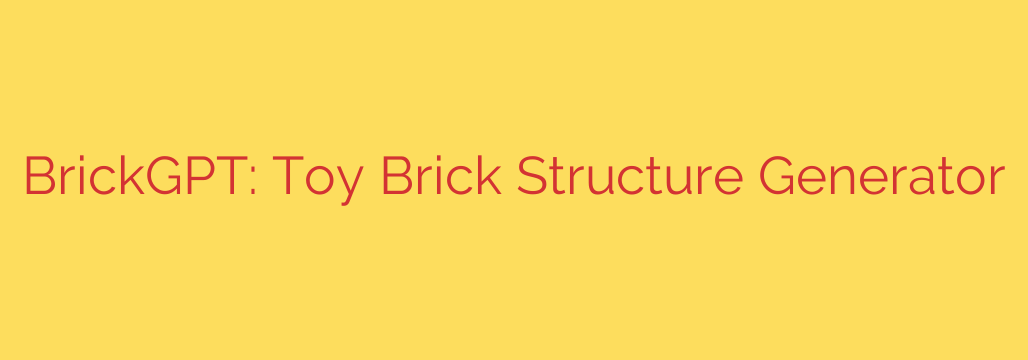
From Text to Toy Bricks: How AI is Revolutionizing Creative Building
Imagine dreaming up a complex toy brick creation—a soaring castle, a futuristic starship, or a quaint village cottage—and then simply describing it to a computer. A few moments later, you receive a complete, step-by-step instruction manual, just like the ones that come in the box, showing you exactly how to build your vision, piece by piece. This isn’t science fiction; it’s the new reality of creative play, powered by cutting-edge artificial intelligence.
A groundbreaking AI system can now act as your personal master builder, translating simple text descriptions into intricate, buildable toy brick models. This technology marks a significant leap forward, moving generative AI beyond the digital realms of text and images and into the tangible world of physical construction.
How AI Becomes a Master Builder
At its core, this innovative process combines the creative language skills of large language models (LLMs) with the logical precision of specialized architectural planners. The system deconstructs the building process into a seamless, intelligent workflow.
It all starts with your idea. A user provides a simple text prompt, such as “a small lighthouse on a rocky cliff” or “a classic red sports car with a spoiler.” The AI then gets to work through a sophisticated, multi-stage process:
- Interpretation: First, a powerful language model analyzes the prompt to understand the key elements, colors, shapes, and relationships. It essentially creates a high-level concept of the final object.
- Structural Planning: This is where the real magic happens. A specialized “layout planner” module acts like an architect. It takes the concept and maps out a 3D structural grid. Crucially, this module considers real-world physics, ensuring the final model is structurally sound and won’t collapse under its own weight. It intelligently plans the placement of bricks layer by layer for maximum stability.
- Brick Selection: With the blueprint in place, a “brick dispatcher” component steps in. This acts as the inventory manager, selecting the specific types, sizes, and colors of bricks needed to execute the plan, carefully choosing pieces that fit together perfectly.
- Instruction Generation: Finally, the system compiles all this information into a familiar, easy-to-follow assembly guide. The end result is a professional-quality, multi-step guide complete with visual aids, showing you which bricks to use and where to place them for each step of the build.
Why This Technology is a Game-Changer
The ability to generate custom building instructions from text has profound implications for creativity, education, and design.
- Democratizing Design: You no longer need to be an expert builder to create something amazing. This technology empowers anyone, from a child to an adult hobbyist, to bring their most ambitious ideas to life. If you can describe it, you can build it.
- Unlocking Limitless Creativity: Say goodbye to “builder’s block.” With an AI co-creator, the possibilities are truly endless. You can experiment with complex architectural styles, fantastical creatures, or replicas of real-world objects without being limited by pre-made kits.
- Educational Potential: This tool is more than just a toy. It serves as an excellent educational platform for teaching fundamental principles of engineering, architecture, and spatial reasoning. Users can see firsthand how a simple idea is translated into a stable, three-dimensional structure.
Tips for Building with an AI Assistant
As this technology becomes more accessible, here are a few tips to get the most out of your AI-powered building experience:
- Be Specific in Your Prompts: The more detail you provide, the better the result. Instead of “a house,” try “a two-story brick house with a blue gabled roof, four windows, and a brown front door.”
- Start with Simpler Concepts: Before you try to build a sprawling metropolis, test the system with smaller, more manageable projects. This will help you understand how the AI interprets commands and plans its structures.
- Think About Your Inventory: The AI will design the ideal model, but it might use bricks you don’t own. Before you start building, review the generated parts list to see if you have the necessary pieces or need to make substitutions.
- Embrace Experimentation: Don’t be afraid to try unusual prompts. Ask for “a car that looks like a fish” or “a treehouse shaped like a mushroom.” The creative and sometimes surprising results are part of the fun.
The line between digital imagination and physical creation is rapidly blurring. This remarkable AI advancement is not just changing how we play with toy bricks—it’s offering a glimpse into a future where our ideas can be instantly transformed into tangible, real-world objects. The only question left is: what will you build first?
Source: https://www.linuxlinks.com/brickgpt-generates-toy-brick-structure/








